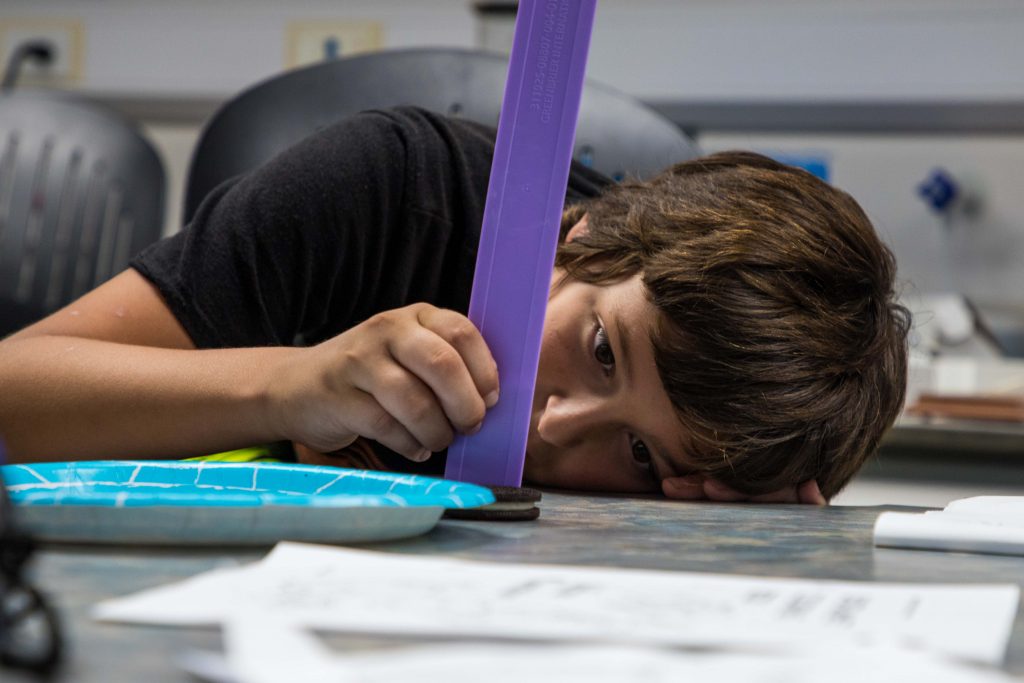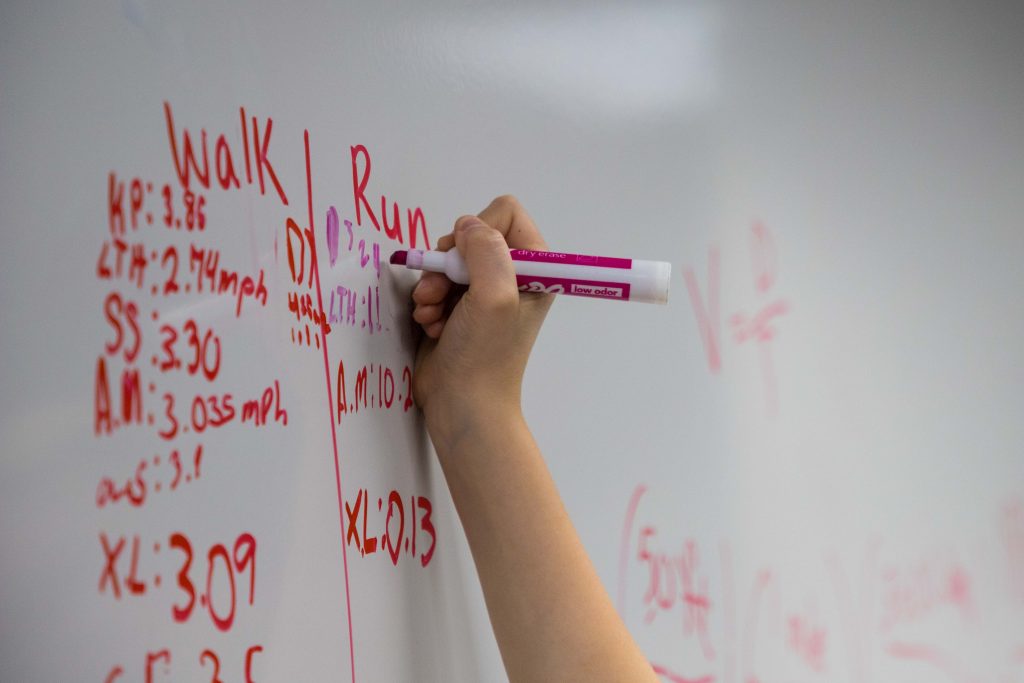July 28, 2023
Written by: Christopher Estrada
SAULT STE. MARIE, Mich.— A quiet university laboratory left vacant for the summer semester soon found itself packed with energy again last week, as K-12 students surrounding Lake Superior State University (LSSU) piled in for an annual summer camp.
The camp, hosted by the Detroit Arsenal based U.S. Army DEVCOM Ground Vehicle Systems Center, is a Department of Defense science, technology, engineering and mathematics focused week of activities, promoting a higher pursuit of STEM careers and providing opportunities to learn more about the subject.

Grayling Mercer, director of the Hoffman Planetarium in Oak Park, Michigan, and OSD-trained STEM K-12 teacher instructs students on safety procedures when preparing to launch their water bottle rockets during a U.S. Army DEVCOM Ground Vehicle Systems Center K-12 STEM Summer Camp at Lake Superior State University, Sault Ste. Marie, Michigan on July 13. The week-long day camp is part of GVSC’s efforts to promote science, technology, engineering and mathematics to K-12 students around Michigan and provide unique, STEM-driven education opportunities to students outside of the typical school year.

A pair of students adds pressure to their water bottle rocket as Grayling Mercer, director of the Hoffman Planetarium in Oak Park, Michigan, and OSD-trained STEM K-12 teacher instructs students on safety procedures at Lake Superior State University, Sault Ste. Marie, Michigan on July 13. The week-long day camp is part of GVSC’s efforts to promote science, technology, engineering and mathematics to K-12 students around Michigan and provide unique, STEM-driven education opportunities to students outside of the typical school year.
Students spend the day on campus at LSSU, taking full advantage of its facilities as they explore a curriculum of varying STEM subjects.
GVSC’s involvement doesn’t end at LSSU, Gregory Chappelle says, who has coordinated GVSC’s DoD STEM program for decades.
“Our main goal when it comes to our STEM programs is educational outreach,” Chappelle said. “We support multiple Native American tribes throughout the state of Michigan as well as several public schools with our summer camps and events.”
This camp in particular draws from the community surrounding the Ojibwe Tribe, bringing in students from the Ojibwe Charter School in Brimley, Michigan, and the Sault Tribes’ Joseph K. Lumdsen Bahweting Anishnabe Academy in Sault Ste. Marie.
Students participate in a variety of DoD STEM K-12 related activities through the week, including a “Human Velocity” experiment, where teams recorded their average running and walking miles per hour and compared it to GVSC’s PackBot robot. Students were later able to control the robot in a demonstration supervised by GVSC Mechanical Engineer Andrew Kosinski.
In another activity, students broke into teams and designed their own 2-liter soda bottle rocket. After receiving a lesson on the physics of flight and watching examples of prior launches, the teams designed their rockets from scratch, launching them in a culminating event that closed out the summer camp.
For some students, what they learn at GVSC’s DoD STEM camps might be their only exposure to science and technology until they progress further in their education. The opportunity to teach such principles to students across Michigan is not lost on the teachers, either.
Nicole Ames-Powell, a mathematics teacher at the Detroit Public Schools Community District, who has been teaching in DoD STEM camps since 2011, says that her personal passion has always been to work with disadvantaged minority students and show them what they’re capable of. To work with several tribal nations and public schools across Michigan in pursuit of that passion resonates with her.

A group of students attempt to catch a plastic fan in the air after their circuit board launched it during a U.S. Army DEVCOM Ground Vehicle Systems Center K-12 STEM Summer Camp at Lake Superior State University, Sault Ste. Marie, Michigan on July 13. The week-long day camp is part of GVSC’s efforts to promote science, technology, engineering and mathematics to K-12 students around Michigan and provide unique, STEM-driven education opportunities to students outside of the typical school year.
“Most Native American students have a strong sense of community and are likely to return to their home communities to reside as adults,” said Ames-Powell. “We give students experiences with STEM activities, concepts, and career options during our camps. Their communities can only benefit by having members return home and work in STEM fields including but not limited to doctors, lawyers, engineers, environmental scientists, educators, and technicians.”
Grayling Mercer, who teaches physics and astronomy at Oak Park Public Schools, and also serves as the planetarium director for Hoffman Planetarium in Oak Park, Michigan, shares a similar sentiment when he travels to teach for DoD STEM camps, as he’s been doing for over 10 years.

A student takes the measurement of an Oreo cookie while determining its volume during a U.S. Army DEVCOM Ground Vehicle Systems Center K-12 STEM Summer Camp at Lake Superior State University, Sault Ste. Marie, Michigan on July 12. The week-long day camp is part of GVSC’s efforts to promote science, technology, engineering and mathematics to K-12 students around Michigan and provide unique, STEM-driven education opportunities to students outside of the typical school year.
“Exposure to STEM is truly the key to showing students that there are so many STEM fields to choose from and every chance to present this to our young people should not be wasted,” Mercer said. “I hope to be able to encourage my students to believe more in their abilities and seize the opportunities available to them.”
Both instructors see their position within the DoD STEM camp as critical to helping students determine what career path to pursue as they get older.
The camp certainly had its influence on the students. Polling a small group after its conclusion indicated almost all had their desire to pursue a STEM-related career field, and all showed an excitement to return to the LSSU camp next year.

A student logs his average run speed after inputting their time into a velocity formula during a U.S. Army DEVCOM Ground Vehicle Systems Center K-12 STEM Summer Camp at Lake Superior State University, Sault Ste. Marie, Michigan on July 12. The week-long day camp is part of GVSC’s efforts to promote science, technology, engineering and mathematics to K-12 students around Michigan and provide unique, STEM-driven education opportunities to students outside of the typical school year.
“I really want to come back next year,” said Crimson Kuzmik, a middle-school student from Ojibwe Charter School. “I got to meet a lot of new people and learn about some things I’d never seen before.”
The camp is funded through Department of Defense grants, together with support in facilities and dining from LSSU and coordination with the surrounding schools, as well as support from Bay Mills Indian Community and the Sault Tribes. Through this camp and others like it across the United States, GVSC and the DoD are hoping to establish the next generation of STEM talent here at home. In doing so, the future workforce remains well-positioned within the top echelon of national security through engineering and innovation.

Gregory Chappelle, DoD STEM Coordinator for U.S. Army Ground Vehicle Systems Center (GVSC) and Andrew Kosinski, Mechanical Engineer at GVSC give students an opportunity to control a U.S. Army GVSC PackBot robot during a U.S. Army DEVCOM GVSC K-12 STEM Summer Camp at Lake Superior State University, Sault Ste. Marie, Michigan on July 13. The week-long day camp is part of GVSC’s efforts to promote science, technology, engineering and mathematics to K-12 students around Michigan and provide unique, STEM-driven education opportunities to students outside of the typical school year.







